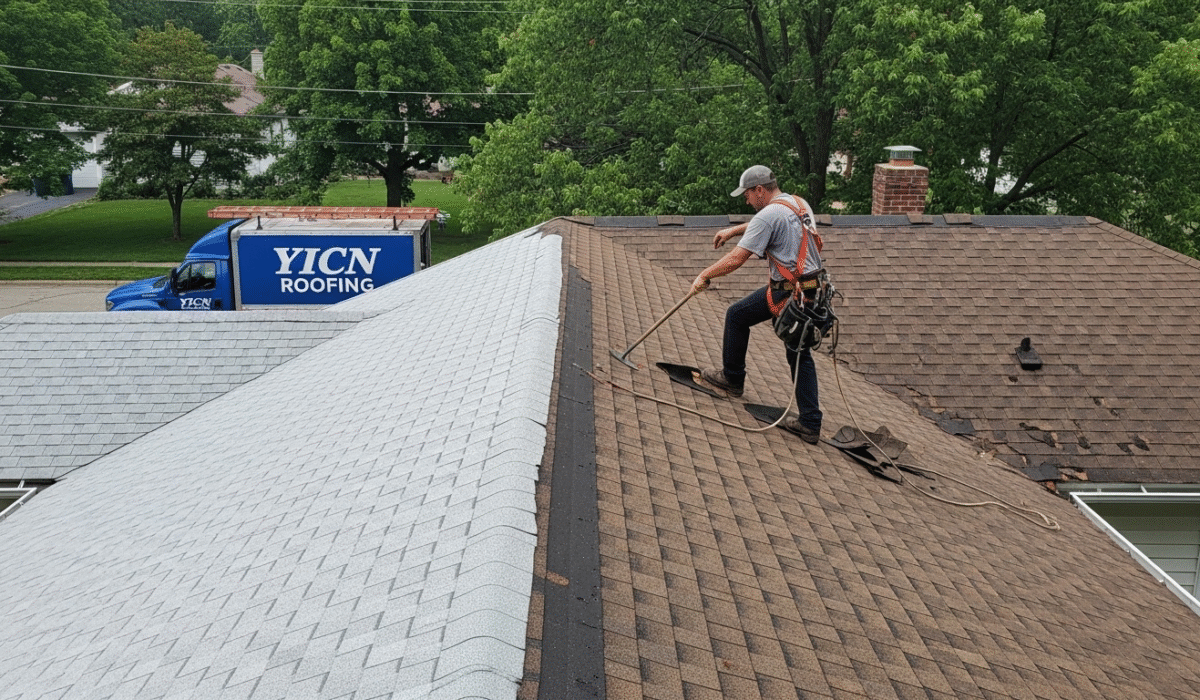- By Kevin Stone
- Roofing
- 1 Comment
Quick Navigation: Introduction Repair vs Replacement Factors to Consider Warning Signs Cost Comparison FAQ
Roof Repair vs Roof Replacement: Making the Right Choice for Your Cleveland Home
Choosing between roof repair and roof replacement depends on the extent of the damage, your budget, and your roof’s age. Minor issues like small leaks, missing shingles, or minor weather damage are often best handled with repairs. However, if your roof is nearing the end of its 20–25 year lifespan, has significant storm damage, or was poorly installed, a full roof replacement may be more cost-effective in the long run. Always consult a certified roofing contractor to assess your specific situation.
Three weeks ago, my neighbor Jim from the Westside neighborhood called me at 6 AM. Water was pourin’ through his kitchen ceiling like a waterfall, and he was standing there with buckets wondering if he needed a quick patch or a whole new roof. Sound familiar?
Here’s the thing – I’ve been doing roofing work around Cleveland for over 7 years now, and I see homeowners make the same mistakes over and over. Some folks spend thousands on repairs when they shoulda just got a replacement. Others panic and replace perfectly good roofs after minor storm damage.
Quick Answer: Roof Repair vs Roof Replacement
Roof repair is a better option for minor damage and localized issues, while roof replacement is more appropriate for extensive damage, aging roofs, or when repairs are no longer a cost-effective solution.
Repairing a roof can be a more budget-friendly and quicker fix for issues like a few missing shingles or small leaks. However, if the roof is old, severely damaged, or has widespread issues, a replacement is often a better long-term investment.
When Repair Makes Sense vs When You Need Replacement
So back to Jim’s situation – after climbing up there (don’t do this yourself, call a licensed professional), I found some loose flashing around his chimney and a couple missing asphalt shingles from last month’s hail storm. Total repair cost? About $450. A full replacement would’ve run him $18,000.
But here’s where it gets tricky. Last year, I had another client in the Ohio City area who kept calling me every few months for different roof leaks. After the sixth repair in 18 months, I had to be straight with her 22-year-old asphalt shingle roof was telling us it was done
Roof Repair: Your Budget-Friendly Option
Pros of Roof Repair:
- Way more affordable for minor issues – we’re talking hundreds instead of thousands
- Much quicker to complete than a full replacement – usually same-day service
- Extends your roof’s lifespan if the damage ain’t too extensive
- Less disruption to your daily routine
- Good for spot fixes like nail pops, loose gutters, or small leak repairs
- Perfect for emergency situations during storm season
Cons of Roof Repair:
- Might just be puttin’ a band-aid on a bigger problem
- Multiple repairs over time can cost more than one replacement
- Can be tough to match materials, especially if your roof’s getting old
- Doesn’t fix underlying structural issues with roof decking
- May only last a few years if your roof is already aging
- Could mask water damage or mold problems in the attic
Roof Replacement: The Big Investment That Pays Off
I’ll never forget Mrs. Rodriguez in Tremont. She kept patching her 19-year-old tile roof every storm season. Finally, after spending $3,200 in repairs over two years, she decided to bite the bullet and get a full metal roof replacement. Three years later, she thanked me because her energy efficiency improved by 25% and she hasn’t had a single leak.
Pros of Roof Replacement:
- Gives you a long-term solution for damaged or aging roofs
- Boosts your home’s value and curb appeal significantly
- Peace of mind knowing your roof system is solid
- New warranty coverage for materials and workmanship
- Better insulation and energy efficiency
- Can handle insurance claims for storm damage
- Modern roofing materials last 30-50 years
- Improved fire resistance and UV ray protection
Cons of Roof Replacement:
- Higher upfront cost than repairs – usually $12,000-$30,000 in Cleveland
- Takes longer to complete – typically 3-7 days depending on weather
- More disruptive to your household
- Requires bigger budget planning and possibly financing
- Need to coordinate with insurance company for claims
- Weather delays can extend the project timeline
Key Factors to Consider: How Do I Decide to Replace or Repair?
This is the million-dollar question I get asked every single day. Here’s my simple rule: if your repair costs are gonna be more than 25% of a new roof, just go with the replacement.
Factor | Repair | Replacement |
Age of Roof | Under 15 years for asphalt shingles | Over 20 years or nearing lifespan |
Extent of Damage | Localized issues, few missing shingles | Widespread damage, multiple leak points |
Cost Comparison | Under $2,000 for repairs | When repairs exceed 25% of replacement cost |
Material Type | Slate or metal can often be repaired | Old asphalt shingles with granule loss |
Future Plans | Staying long-term, budget tight | Selling soon, want maximum value |
Age Matters More Than You Think
Here’s what most homeowners don’t realize – roofing materials have different lifespans. Asphalt shingles typically last 15-25 years, metal roofs can go 40-70 years, and slate can last over 100 years if maintained properly.
- Three-tab shingles: 15-20 years (cheapest option)
- Architectural shingles: 20-30 years (most popular)
- Metal roofing: 40-70 years (best long-term value)
- Slate or tile: 50-100+ years (highest upfront cost)
- Flat roof materials (TPO, EPDM, PVC): 15-30 years
Warning Signs Your Roof Needs Attention
Last month, I was doing an inspection in Lakewood when the homeowner asked me “How do I know if my roof is ok?” Great question! Here’s what I always tell folks to look out for:
Signs You Need Repair:
- A few missing or damaged shingles after a storm
- Small leaks in one specific area
- Loose or damaged flashing around chimneys or vents
- Granules in your gutters (some is normal, lots isn’t)
- Nail pops or exposed nails
- Minor moss growth on north-facing slopes
- Sagging in small sections
Signs You Need Replacement:
- Widespread granule loss making shingles look bald
- Multiple leaks in different areas
- Shingles that are curling, cracking, or completely missing
- Daylight visible through roof boards in the attic
- Water stains on ceilings or walls
- Sagging roof deck or structural issues
- Algae streaks or severe discoloration
- Energy bills going up due to poor insulation
Safety Warning: Never climb on your roof yourself, especially during wet or icy conditions. Always call a licensed roofing contractor for inspections.
Cost Breakdown: Repair vs Replacement in Cleveland
Money talks, right? Here’s what you can expect to pay around Cleveland based on my experience with hundreds of projects:
Typical Repair Costs:
Replacement Costs by Material:
- Asphalt shingles: $8,000-$15,000 (most affordable)
- Architectural shingles: $12,000-$18,000
- Metal roofing: $15,000-$25,000
Slate or tile: $20,000-$40,000+
Flat roof (TPO/EPDM): $10,000-$20,000
Seasonal Considerations for Cleveland Homeowners
Living in Cleveland, we deal with some crazy weather. Here’s when I recommend doing repairs vs replacements:
Best Times for Roof Work:
- Spring (April-May): Perfect for repairs after winter damage
- Early Summer (June-July): Ideal for replacements, good weather
- Fall (September-October): Last chance before winter, great for inspections
Emergency Repairs During Cleveland Winters:
Ice dams are huge problems here. I’ve seen gutters ripped right off houses. If you’re dealing with emergency leaks during winter, call for temporary repairs but plan for permanent fixes in spring.
Need Help Deciding?
Get a free inspection and estimate from our certified roofing contractors. We’re licensed, insured, and have over 100+ satisfied customers in Cleveland.
Call for Same-Day Service: (216) 999-4342
Frequently Asked Questions
What is the rule for repair or replace?
My simple rule: if repair costs exceed 25% of replacement cost, go with replacement. Also consider the age – if your roof is over 75% of its expected lifespan, replacement usually makes more sense.
What is the most common roof repair?
Shingle replacement and flashing repairs are the most common. Around Cleveland, we also see a lot of gutter damage from ice and storm damage from hail.
How long should a roof last?
The lifespan of a roof depends on the material, installation quality, weather exposure, and maintenance. Here’s a general breakdown by roofing material:
Average Lifespan by Roofing Type:
Roofing Material | Average Lifespan |
Asphalt Shingles | 15–30 years |
Architectural Shingles | 25–40 years |
Metal Roofing | 40–70 years |
Clay Tile | 50–100+ years |
Slate | 75–200 years |
Wood Shakes/Shingles | 20–40 years |
EPDM (Rubber) | 20–30 years (flat roof) |
TPO/PVC (Flat Roofing) | 15–30 years |
Should I replace my roof if it’s not leaking?
If your roof is nearing the end of its lifespan (like 20+ years for asphalt shingles), replacement can prevent damage and save money long-term. Don’t wait for leaks – by then, you might have water damage in your attic or walls.
What type of roof adds the most value to a home?
Architectural shingles give the best bang for your buck. Metal roofing adds more value but costs more upfront. Slate and tile are premium options that can significantly boost curb appeal and home value.
Can a roof last 30 years?
Yes! Architectural shingles can last 25-30 years with proper maintenance. Metal roofs easily last 30+ years, and slate or tile can go 50-100+ years.
What is the best time to replace a roof?
Late spring through early fall is best. Avoid winter installations if possible. In Cleveland, I recommend June-September for replacements to avoid weather delays.
What damages a roof the most?
Hail, wind damage, ice dams, and poor ventilation are the biggest culprits in Cleveland. UV rays and weather cycles also cause wear and tear over time.
How do I know if my roof is safe?
Schedule regular inspections with a professional. Look for warning signs like leaks, sagging, missing shingles, or granules in gutters. Don’t walk on your roof yourself.
How long should a roof last?
Depends on the material. Asphalt shingles last 15-25 years, metal can go 40-70 years, and slate can last over 100 years. Climate and maintenance affect lifespan too.


1 Comment